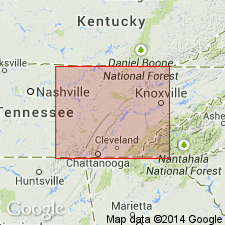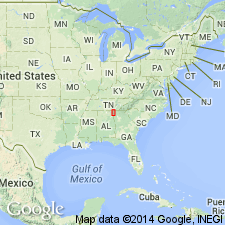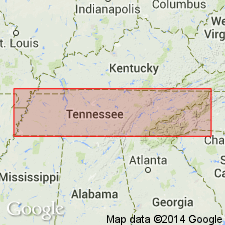
- Usage in publication:
-
- Signal Point shale
- Modifications:
-
- Named
- Dominant lithology:
-
- Shale
- AAPG geologic province:
-
- Appalachian basin
Summary:
Named as a formation in Gizzard group. Named for Signal Point, Hamilton Co., eastern TN. Consists of shale, as well as several widely mined coals (Angel, Ravenscroft, and Wilder coals). Thickness at type section is 52 ft; thins westward to 10 ft at type section of Gizzard group; along eastern edge of Walden Ridge, averages about 60 ft. Overlies Warren Point sandstone (revised); underlies Sewanee conglomerate (revised) of Crab Orchard Mountains group (new). Along Western Escarpment, commonly very thin and locally completely truncated by Sewanee. North of Monterey, inseparable from units above and below and equivalent strata are therefore assigned to Fentress formation. Age is Pennsylvanian (Pottsville series). Report includes geologic maps, cross sections, stratigraphic sections, and correlation chart.
Source: GNU records (USGS DDS-6; Reston GNULEX).

- Usage in publication:
-
- Signal Point Shale Member*
- Modifications:
-
- Revised
- Areal extent
- AAPG geologic province:
-
- Appalachian basin
Summary:
Unit geographically extended into northwestern GA and reduced to member status at top of Gizzard Formation. Consists of 6 to 50 ft of gray shale with locally contains a thin coal bed and a thin sandstone. Overlies Warren Point Member. Underlies Sewanee Member of Crab Orchard Mountains Formation.
Source: GNU records (USGS DDS-6; Reston GNULEX).

- Usage in publication:
-
- Signal Point Shale
- Modifications:
-
- Areal extent
- AAPG geologic province:
-
- Appalachian basin
Summary:
(East-central sheet; not separately mapped.) Signal Point Shale of Gizzard Group. Mostly dark-gray to light-brown shale with minor siltstone. Wilder coal near top. Thickness 0 to 180 feet, average about 60 feet. Top formation of Gizzard Group. Lies below Sewanee Conglomerate of Crab Orchard Mountains Group and above Warren Point Sandstone of Gizzard Group. Age is Pennsylvanian.
Source: Publication.
For more information, please contact Nancy Stamm, Geologic Names Committee Secretary.
Asterisk (*) indicates published by U.S. Geological Survey authors.
"No current usage" (†) implies that a name has been abandoned or has fallen into disuse. Former usage and, if known, replacement name given in parentheses ( ).
Slash (/) indicates name conflicts with nomenclatural guidelines (CSN, 1933; ACSN, 1961, 1970; NACSN, 1983, 2005, 2021). May be explained within brackets ([ ]).

